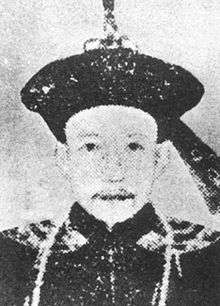Niohuru

The Niohuru (Manchu: ᠨᡳᠣᡥᡠᡵᡠ ; Chinese: 鈕祜祿; pinyin: Niǔhùlù; Wade–Giles: Niu3-hu4-lu4; literally: "wolf" in Manchu) were a prominent Manchu clan during the Qing dynasty. The clan had inhabited the Changbai Mountains since as early as the Liao dynasty. The clan was well known during the Qing dynasty for producing a variety of consorts of all ranks for emperors, several of whom went on to become mothers to reigning emperors. Prominent people who belonged or trace heritage to the Niohuru clan including famed Manchu warrior Eidu, his son the high official Ebilun, the Empress Dowager Ci'an, the infamous corrupt official Heshen, and the contemporary concert pianist Lang Lang.
Distribution
Written records of the Niohuru clan dates back to the Liao dynasty (907–1125), when it was known as the Dilie clan (敌烈氏) by Chinese transliteration. The current transliteration Niohuru came into being during the Ming dynasty. The Niohuru clan inhabited the Changbai mountains region of present-day Jilin province in northeast China (otherwise known as "Manchuria"), and also on the banks of the Songhua River and Mudan River.
According to members of the clan who attempted to re-trace their genealogy, the common primogenitor of the vast tribe date back to one Sohoji Bayan (honorific Su Gung), who was six generations removed from Eidu, the first eminent Niohuru clan member in recorded Qing history.[1] The Niohuru were widely distributed throughout the territory of the Manchu empire, and each of the Eight Banners had some Niohurus among their ranks.
Towards the end of the Qing dynasty and particularly after the founding the Republic of China in 1912, many Manchus adopted single-character Chinese surnames based on their clan origin. The Niohuru were known to have adopted to two versions, "Niu" (钮), which could be found in the modern province of Jiangxi[2] in addition to Manchuria; and "Lang". Lang sounded like "wolf" in Chinese, roughly corresponding to the Manchu root word Niohe for Niohuru meaning "wolf".[3]
Famous members
Qing dynasty
- Eidu, Manchu noble, close associate of Nurhaci
- Turgei, Eidu's eighth son, officer of Manchu armies during the reign of Hong Taiji
- Ebilun, Eidu's youngest son, one of the four regents during the minority of the Kangxi Emperor
- Empress Xiaozhaoren, consort to the Kangxi Emperor
- Empress Xiaoshengxian, consort to the Yongzheng Emperor, mother of the Qianlong Emperor
- Imperial Noble Consort Gongshun, consort to the Jiaqing Emperor
- Empress Xiaomucheng, imperial consort to the Daoguang Emperor
- Empress Xiaoquancheng, biological mother of the Xianfeng Emperor
- Empress Dowager Ci'an, principal consort to the Xianfeng Emperor, regent during the reign of the Tongzhi Emperor
- Heshen, infamous official of the late Qianlong era
- Necin, Manchu overseer of the Board of War during the Qianlong era
After Qing dynasty
- Sihung Lung, Taiwan actor
- Doze Niu, Taiwan director
- Niu Maosheng, Governor of Hebei
- Larry Hsien Ping Lang, Hong Kong economist
- Lang Lang, internationally renowned concert pianist
See also
References
- ↑ Hoong Teik Toh (2005). Materials for a Genealogy of the Niohuru Clan: With Introductory Remarks on Manchu Onomastics. Otto Harrassowitz Verlag. pp. 4–. ISBN 978-3-447-05196-5.
- ↑ Pamela Crossley (2002). Manchus: People of Asia (reprint, illustrated ed.). Blackwell Publishers. p. 55. Retrieved March 25, 2012.
When they were young, Alechi saved Nurhaci's life by killing a wild hyena.
- ↑ Edward J. M. Rhoads (2001). Manchus & Han: ethnic relations and political power in late Qing and early republican China, 1861-1928 (reprint, illustrated ed.). University of Washington Press. p. 56. Retrieved March 2, 2012.
and when the ancient and politically prominent Manchu lineage of Niohuru adopted the Han-style surname Lang, he ridiculed them for having "forgotten their roots." (The Niohuru, whose name was derived from niohe, Manchu for wolf," had chosen Lang as their surname because it was a homophone for the Chinese word for "wolf.")
- ↑ https://m.repository.library.georgetown.edu/bitstream/handle/10822/761498/Gregory_georgetown_0076D_13086.pdf?sequence=1&isAllowed=y p. 205.
- ↑ The Dynastic Centre and the Provinces: Agents and Interactions. BRILL. 17 April 2014. pp. 52–. ISBN 978-90-04-27209-5.
- ↑ Hoong Teik Toh (2005). Materials for a Genealogy of the Niohuru Clan: With Introductory Remarks on Manchu Onomastics. Otto Harrassowitz Verlag. pp. 11–. ISBN 978-3-447-05196-5.
- ↑ Mark C. Elliott (2009). Emperor Qianlong: Son of Heaven, Man of the World. Longman. p. 63. ISBN 978-0-321-08444-6.
- ↑ Yingcong Dai (1 March 2011). The Sichuan Frontier and Tibet: imperial strategy in the early Qing. University of Washington Press. pp. 128–. ISBN 978-0-295-80070-7.